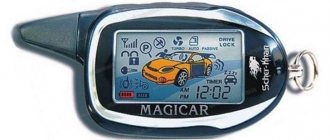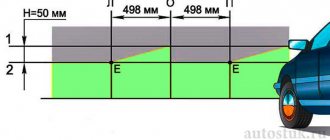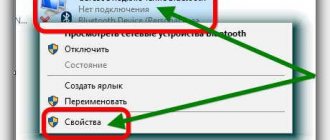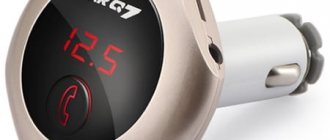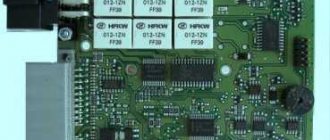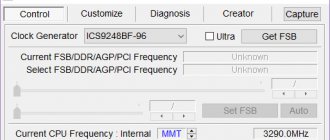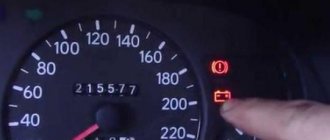We confirm the malfunction
Before you begin troubleshooting, you should make sure that the failure to print is due to the specified operating system service. To check its condition, let's find it among the other components in the list. To do this you need to follow a few simple steps.
- Open the quick command window using the combination Windows + R.
- Enter the command “services.msc”.
- We are waiting for the list of services to open.
- Find “Print Spooler” in the list and double-click on it.
Now you need to make sure that it is stopped and not running. We look at the corresponding labels in the properties window, as shown in the figure below. If necessary, we change to the required ones and forcefully launch them to “revive” the operation of the printers. Change the startup type to “Automatic” and click on the “Run” button, and then “Apply” and “OK”.
There is no print service in the list of services
There are times when we may not find the printing service we need in a long list. Then you can search for “Printers Spooler” if you are using the English interface of Windows OS. Even if nothing is found, the situation is quite problematic. This means that the user (you or someone else) accidentally or without knowing it deleted important files in the system folders on the Windows drive. Another reason for the disappearance of the print manager may be the presence of malware, or simply viruses, on the PC. The solution could be:
- Check the system registry, namely the value of the DependOnService parameter in the HKEY_LOCAL_MACHINE/SYSTEM/CurrentControlSet/Services/Spooler branch. It should be equal to "RPCSS http". Change if inconsistent. You can enter the editor through quick launch (Windows + R) and the “regedit” command.
- Cleaning your computer from viruses with a full-fledged antivirus or a one-time free utility.
- Return to a restore point, if one was created.
- Complete system reinstallation.
Force clearing the print queue
The easiest way to get rid of the problem is to clean out the %SystemRoot%\System32\spool\PRINTERS . This folder stores documents sent to the print queue. When the spool folder becomes full, the print scheduler (spoolsv.exe) crashes and causes the service to crash or stop.
The problem is relevant for corporate computers, where many documents can be sent for printing at the same time. The error does not depend on the version of Windows: the problem appears both on server Windows Server 2008/2012 (and others), and on any builds of Windows 7 and 10 (as well as 8/8.1, XP, Vista - the problem is everywhere).
To force clear the print queue:
- Open the c:\windows\System32\spool\printers folder on the computer to which the printer is connected via USB.
- Delete all files in the folder - these are the documents from the print job that caused the service to hang up.
- Restart the service. By default, the autostart service should be set to “Automatic”, so it is enough to resend the document for printing.
- If not, you need to go to “Start” - “Control Panel” - “Administration” - “Service Components” - “Local Services”, find “Print Manager” in the list and restart the service.
- The document should print normally.
Resubmitting the same document for printing may disable the print spooler service again. This especially often occurs when trying to print a document in PDF format on an old printer with outdated drivers. In this case, there are only two options: either try to get rid of freezes and crashes by reinstalling the drivers, or change the printer to a newer model.
Uninstalling and reinstalling printer drivers
Print Spooler may be disabled on any version of Windows when you try to print a PDF document. Restarting the print spooler service or clearing the queue will not help, since the printer simply does not accept such a document and does not know how to process it.
There are two options to solve the problem:
- Save the file in a format other than PDF. Restart the service and send the document for printing - everything should print without problems.
- Update drivers. Remove old drivers: stop the print spooler service, delete all contents from the \System32\spool\drivers . Install new drivers: they can be taken either on the disk that comes with the printer, or downloaded from the device manufacturer’s website (HP, Canon, Xerox).
If you need to print a document quickly, you should save it in a different format. This can be .jpeg and .png if the document contains a lot of graphics, or any of the text formats (txt, doc, docx, rtf) for documents with text.
To translate text into another format, you can use installed graphic or text editors. An alternative option is to use one of the many online services that offer to change the document format without changing its content. This will ensure that you do not lose the ability to use the printer while searching for a solution to the problem.
For the purity of the experiment, you can remove all drivers and printers that are known to Windows. After that, add devices and install drivers one by one to find out at what point/driver the error occurs. After you remove or install printers, you must restart your computer for the changes to take effect.
Alternative methods to solve the problem
If the previous methods did not help, the chance of further successfully solving the problem is not great. On the Internet you can find a lot of advice on cleaning your computer or checking the system for viruses - they say, these reasons can cause problems with the print manager crashing. In reality, such a chance is minimal.
Also, you should not immediately try to reinstall Windows or roll back the system to a restore point. The problem does often appear on HP and Canon printers after a series of updates to Windows 7 and 10. Rolling back the update using a restore point may temporarily solve the problem, but it will reappear after updating the PC.
Causes of problems with the dispatcher
To understand further manipulations on the computer, you should highlight the reasons why the print service may stop.
- Malicious software negatively affects the operation or attempts to start various services, which leads to problems with the operation of the printer.
- Some critical system files have been deleted by the user or by viruses.
- The drivers that are responsible for the correct operation of the printer are outdated. Or they are incompatible with the latest Windows update and cause a conflict.
- The service is down due to problems with other services that the print spooler directly depends on.
Ways to fix the problem
Reboot PC
If the disappearance of the list of printers from the “Print” menu of various programs that allow this action is infrequent, then restarting your personal computer or laptop can help with the problem. But if the same incidents happen again in the future, then this solution option is clearly not suitable in such a situation.
Launch setup
The first step is to double-check the settings of the service and those on which it depends. Following the instructions described in the very first paragraph of the article, go to the service properties. On the “General” tab, in the “Startup Type” section, select “Automatic” without “Delayed Start”. “Status” is changed to “Working” if it is different at the moment. Use the “Run” button. Don't forget to apply and save the settings. The bookmark should look like this.
Go to the “Dependencies” tab and look at what services are listed there. Their operation and settings also need to be double-checked and, if necessary, configured correctly. Remote Procedure Call (RPC) can easily be found in the same list in the Services window.
It would be a good idea to configure the behavior of the service in case of failures. This is done on the “Recovery” tab. We set the “Restart” mode for the first and second failure.
Virus check and system scan
As has already been mentioned many times, the problem is often the presence of malicious software on the PC, or popularly known as “viruses”. To remove this reason from the list of possible causes, you need to perform a deep scan of the system and remove malicious files. For such purposes, you can use a standard, previously installed antivirus with fresh databases. If this is not the case or updating to the latest version is problematic, then use any free one-time scanner. An excellent option for such purposes is Cureit from. It is recommended to download from the company's official website.
After scanning, treating damaged files and removing malicious ones, experts recommend checking the integrity of Windows itself. In this case, you should use the built-in utility “sfc”, which can do everything itself without user intervention or settings on his part. The procedure is as follows:
- Open the launch window using the Windows + R keys.
- Enter the command "cmd" to launch the command prompt.
- In it, run “sfc /scannow”.
- Be patient and wait for the process to complete.
- When finished, restart your computer.
Correction using Windows
As another simple and quick option, you can consider correcting the situation using the built-in tools of the operating system itself. To do this, through the control panel, go to the “Troubleshooting” section, and in it select “Hardware and Sound”. In the list that opens, find the “Printer” shortcut.
If you use several printing devices, the system will prompt you to select the problematic one. Then we follow the wizard’s instructions and the utility’s prompts. Simple problems will be fixed without your direct participation. But automatic corrections may not always be enough for a positive result.
Clearing the print queue
Often, a large number of tasks sent to the printer may hang. This creates a queue that interferes with the normal operation of printing devices. All the user needs to do is clear this queue. This procedure can be done in several ways.
- Clearing the temporary folder.
- Command line.
- Special Bat file.
- Third party utilities.
To perform the first method, you need to find the folder “C:\Windows\system32\spool\PRINTERS” on the system drive, and most likely it is “C:/” and delete everything that is there. This will clear the print queue as quickly as possible. Files may not be deleted if the print service is running. You need to stop it for the duration of cleaning, and then turn it back on.
All ways to remove documents from the queue. Detailed description of the steps for each cleaning option.
Reinstalling the driver
Drivers can affect the Print Spooler service for many reasons.
- The installed “firewood” from the installation disk is intended for earlier versions of Windows.
- You have updated your operating system to the latest version, which conflicts with the printer software.
- Files are damaged by users or malware.
The only solution in this situation is to reinstall the driver. It is critical that these are the latest drivers for your printing device model. Of course, you can and should only download them from the official website of the printer manufacturer.
Detailed instructions for installing the printer driver. Links to download the latest software versions for different brands.
It is important to correctly and completely remove old drivers before installing new versions so that not the slightest trace of them remains in the system. To do this you need:
- Uninstall the device itself in the “Devices and Printers” section of the control panel. To enter this section, use special commands. First Windows + R, and then “control printers”. Select the desired model and use the right mouse button to “Delete”.
- Remove the driver package via the print server.
We start the server, and on the “Driver” tab we remove the required package.
In some cases, you may need to stop the print service if it is running. - If necessary, clean the registry or use special utilities.
Other options to remove the printer driver from the operating system Description of each step to completely remove the device software.
Collection of fresh drivers Download from direct links.
Installing a printer via a local port
In some cases, installing printing equipment through a local one helps with problems with the print manager. Try this by following these steps:
- Open the printers section through the control panel.
- There, in the menu at the top, select “Install”.
- In the window, click on the first option “Add local”.
- Next, “Create a new port” and select “Local Port” from the list.
- Specify any port value.
- Next, follow the instructions of the installation wizard.
Network solution
A universal solution is the local port connection method. With this method, you manually specify the path with which the system should work.
To do this, follow the instructions:
- Go to the Control Panel using one of the methods described in the previous method for solving the problem;
- Go to the Printers and devices section (or Hardware and Sound, and from there – Add a device, if you have Windows 10 installed on your PC);
- Click on the Install button at the top of the window that opens;
- A window opens listing possible device options - click on the Add printer section;
- In the window that opens, find the Create a new port field and place a marker in the box opposite the inscription;
- Below in the drop-down list of the Port Type section, specify Local Port;
- Click on the Next button at the bottom of the window;
- A small window will open in which you need to enter the path to it (although it is called Port Name), you must take into account spaces, case, etc.;
- Click OK;
- In the next window, select the necessary driver for normal operation of the device (downloaded or loaded from a memory card or disk);
- Click Next again;
- Then click on the Next button several more times, agreeing with what the Port Creation Wizard suggests, until the window closes.
After this, restart your computer. It should now work properly. If this does not happen, then check the spelling of the path again.
When trying to connect a new printer and in some other cases related to printing materials from a computer, the user may encounter the error “The local printing subsystem is not running.” Let's find out what it is and how to fix this problem on a Windows 7 PC.
The most common cause of the error studied in this article is the disabling of the corresponding service. This may be due to its deliberate or erroneous deactivation by one of the users with access to the PC, various malfunctions of the computer, and also be a consequence of a virus infection. The main ways to eliminate this problem will be described below.
Method 1: Component Manager
One way to start the desired service is to activate it through the “Component Manager”
.
- Click Start
.
Go to "Control Panel"
. - Click Programs
. - Next, click “Programs and Features”
. - On the left side of the shell that opens, click “Turn Windows features on or off
. - The Component Manager
starts .
You may have to wait a short time while the list of items is built. Find among them the name “Print and Document Service”
. Click on the plus sign located to the left of the above folder. - Next, click on the checkbox to the left of “Print and Document Services”
. Click until it becomes empty. - Then click on the named checkbox again. There should now be a checkbox next to it. Place the same mark next to all elements included in the above folder where it is not installed. Next, click “OK”
. - After this, the procedure for changing functions in Windows will be performed.
- After completing this operation, a dialog box will open asking you to restart the PC to make the final change of settings. You can do this immediately by clicking on the "Restart Now"
.
But before doing this, do not forget to close all active programs and documents to avoid losing unsaved data. But you can also click on the “Restart later”
. In this case, the changes will take effect after you restart the computer in the standard way.
After restarting the PC, the error we are studying should disappear.
Method 2: "Service Manager"
You can activate the associated service to resolve the error we are describing through the “Service Manager”
.
- Go through “Start”
to
“Control Panel”
.
How to do this was explained in Method 1
.
Next, select “System and Security”
. - Go to "Administration"
. - In the list that opens, select “Services”
. - "Service Manager"
is activated .
Here you need to find the element “Print Manager”
.
For a faster search, arrange all names in alphabetical order by clicking on the name of the “Name”
.
If
there is no value
“Status” “Running”
, this means that the service is deactivated. To launch it, double-click on the name with the left mouse button. - The service properties interface is launched. In the “Startup Type”
, select
“Automatic”
.
Click "Apply"
and
"OK"
. - Returning to the “Manager”
, re-select the name of the same object and click
“Run”
. - The service activation procedure is in progress.
- After its completion,
“Working”
should appear “Print Manager” .
Now the error we are studying should disappear and no longer appear when trying to connect a new printer.
Method 3: Restore system files
The error we are studying may also be a consequence of a violation of the structure of system files. To eliminate such a possibility or, conversely, correct the situation, you should check your computer with the “SFC”
followed by a procedure for restoring OS elements if necessary.
- Click Start
and go to
All Programs
. - Navigate to the "Standard"
. - Find "Command Prompt"
.
Right-click on this element. Click Run as administrator
. - Activated "Command line"
. Enter the following expression into it:Click Enter
.
- The procedure will begin to check the system for the integrity of its files. This process will take some time, so be prepared to wait. the “Command Prompt”
under any circumstances , but if necessary, you can minimize it to
the “Taskbar”
. If any inconsistencies are identified in the OS structure, they will be corrected immediately. - However, it is possible that if there are errors found in the files, the problem cannot be fixed immediately. Then you should repeat the check with the SFC
in
Safe Mode
.
Method 4: Check for viral infection
One of the root causes of the problem under study may be a virus infection of the computer. If you have such suspicions, you need to scan your PC with one of the anti-virus utilities. This must be done from another computer, from a LiveCD/USB, or by logging into your PC in “Safe Mode”
.
If the utility detects a virus infection on your computer, act according to the recommendations it gives. But even after performing the treatment procedure, there is a high probability that the malicious code managed to change the system settings, so in order to eliminate the error in the local printing subsystem, it will be necessary to reconfigure the PC using the algorithms described in the previous methods.
As you can see, in Windows 7 there are several ways to resolve the error “The local printing subsystem is not running”
. But there are not so many of them in comparison with the options for solving other computer problems. Therefore, it will not be particularly difficult to eliminate the malfunction if necessary, try all of the above methods. But, in any case, we recommend checking your PC for viruses.
What to do if the spooler is heavily loading the processor
Many users of different versions of Windows often complain that the “spooler” process heavily loads the processor. The problem becomes more acute when utilization starts to reach the 80 percent mark. This is truly an atypical situation and such loading should not happen. Let's consider the possible causes and their quick independent solution.
- There is a large queue of print jobs or very large files. We simply clear the list of tasks and split the large file into several parts accordingly.
- The list of printers includes many models that are generally or very rarely used. It is better to delete them, since the print service has to constantly “monitor” them, which causes additional load.
- An outdated or broken driver can itself have a negative impact and consume a lot of resources. In this case, reinstallation is inevitable.
It is not possible to reinstall the entire service separately from the operating system. To resume its correct operation, you can only try to perform the above steps.
What was your reason?
- Unclear*60%, 15 votes
15 votes 60%15 votes - 60% of all votes
- The service was simply stopped 32%, 8 votes
8 votes 32%
8 votes - 32% of all votes
- Drivers 4%, 1 vote
1 vote 4%
1 vote - 4% of all votes
- Lots of jobs in the print queue 4%, 1 vote
1 vote 4%
1 vote - 4% of all votes
- Viruses 0%, 0 votes
0 votes
0 votes - 0% of all votes
Total votes: 25
15.04.2019
×
You or from your IP have already voted.


